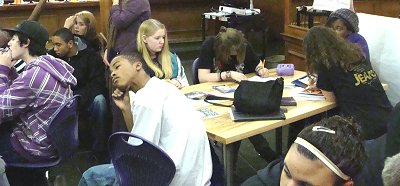- By Dan Veaner
- Around Town
 Print
Print  Part 3: Impact of a Charter School
Part 3: Impact of a Charter School| Last week we presented a look at New Roots Charter School was formed. This week we report on the impact the school has on various aspects of the communities. Part 1: Inside New Roots Part 2: Building a School Part 3: New Roots' Impact | ||
"It grew out of my strong conviction that in times where we're seeing rapid change in terms of the climate and the economy -- all these big changes that we can see right on our horizon will require that young people coming of age now have a kind of resilience and ability to solve problems, a flexibility and capacity for collaboration and developing community that our traditional 20th century schools just don't fully support," she says.

For a lot of New Roots parents, the bottom line is finding the best educational experience for their kids that gives students the best opportunities to succeed. It is not a matter of district school systems doing a bad job so much as it is a round hole / square peg issue. There are a lot of reasons a student may do poorly in a school. It doesn't mean a student is stupid or that the school is doing something wrong for the majority of its students. It often means that the way a particular student learns is too different from the way the school teaches. Many New Roots parents will tell you that their 'square peg' children have found a 'square hole' in New Roots.
"I hear that word 'transformed' again and again," Nilsen-Hodges says. "I hear that feedback from parents and see it myself in the ways kids present themselves. Some students who came in with their guard up are now relaxing into being themselves and engaging with their school work and school experience in new ways. I think that is the typical New Roots experience at this point."
Students who chose to go to New Roots, this year in particular, made a difficult and brave decision. They would be cut off from the familiar. Friends and comfortable expectations are important to high-school-aged teenagers. For the almost 100 students who have stayed at New Roots, the school has provided a vital and exciting environment to learn in. They have made new friends and kept old ones. Several parents report that for the first time their children look forward to going to school every day.
In terms of financial impact, it depends on your point of view. School districts are billed tuition for charter schools based on a formula that sets the per-pupil expenditure for a district. Of the communities that send students to New Roots Lansing has the highest annual tuition of $12,850. Originally it was thought nine Lansing students would attend New Roots this year, but at this time there are five. The Lansing school district also pays an additional $4,346.10/year for special education students -- there is one from Lansing at this time. The district must also provide transportation for New Roots students, and make available the equivalent of the aid it receives per-student for texts, software, library materials and health and welfare services.
One way to look at it is that the money follows the student -- no harm, no foul. If that student weren't in the district the money wouldn't be there anyway. Another view is to say that it is money taken away from the district in a way that could impact programs there.
"If I am taking a student out of 10th grade that's not really going to impact the number of teachers I need in the 10th grade program," says Lansing Central School District business Administrator Mary June King. "It's not going to cut any costs for me to remove that student from campus, but I'm paying to put that student somewhere else. While there is a direct cost I'm not sure there are indirect refunds on that cost. If they were taking 30 kids from the sophomore class we might be able to cut one section of each of the courses being taught at that grade level, theoretically. But that's not how it pans out."

But charter schools are not the only outside institutions that school districts are required to contribute to. Lansing is responsible for providing an educational program at the Tompkins County Jail, and actually employs a teacher for that purpose. District dollars also follow students who attend private schools, and places where special needs students may be. For example, the district is billed for tutoring of its students who are placed in drug rehabilitation facilities or other like institutions. From one point of view all of these things are part of the cost of doing business for school districts. Lansing school officials say that the first year was the most difficult because there was no way to predict the dollar impact, but going forward it will just be another line item to plan for in the budgeting process.
Both King and Superintendent Stephen Grimm have said that the Lansing district may be able to take some lessons from the things that are successful at New Roots. King says that some day the member districts of the local BOCES might choose to specialize with one high school focusing on the arts, another on technology, another on agriculture, etc., each with a different teaching style and purpose, with students from all the districts able to choose the school that fits them best. For now she says that New Roots may be filling that kind of function.
"Really and truly, the bottom line is that we are educators," King says. "If our round hole doesn't fit every kid, then by our very definition we want to see if we can find that square hole that will. New Roots may be one of those square holes. If we are being competitive we have nothing to worry about. If we are doing our job right we have nothing to worry about. There will be a handful of square pegs and (the charter school) may be the best fit for them -- no harm, no foul. If we see a massive migration of Lansing kids to New Roots then clearly we're doing something wrong."
It is difficult to assess exactly how much extra it costs to send students to a different school. When you ask school officials they talk about complicated state formulas for determining aid that make it hard to pin down the cost. Few have claimed that New Roots has had an actual negative impact on Lansing's district programs.
A small group of opponents that characterize themselves as the 'Coalition for Sustainable Schools' has conducted a vitriolic campaign against the school, at first in an attempt to prevent New Roots from receiving its charter, and now to challenge it at every turn. Most visible are Corinne Frantz & Patricia Ehrich, who have accused the school of dishonest reporting and recruiting, frequently turn up at school meetings to criticize the school, have peppered it with countless Freedom Of Information Law (FOIL) demands, and have filed formal complaints with the Charter Schools Institute of SUNY, the chartering authority for New Roots. They have also been quite aggressive about demanding information from the affected school districts, as well as the Charter Schools Institute.
While district administrators and Nilsen-Hodges alike agree that anyone has the right to this information, they also say that Frantz and Ehrich take up a lot of staff time and resources. So far the charges they have leveled have not proved to be substantive, and their aggressive negativism has been noted by many both privately and in the local press.
"They constantly want updates on the information," King says. "I'm fine with that, but I don't feel that we need to develop a negative relationship with New Roots, so don't set me up to be a pawn in your war. I don't mind giving anybody information, but don't think that I'm going to play a role in it."
"It's unfortunate for an organization whose mission is to serve kids and families," Nilsen-Hodges says. "I feel impatient about any time that needs to be spent on anything but serving that mission. We have to take care of the kids that are in our charge. Any minutes spent thinking, talking about, or responding to requests of people who are not supporting our kids is a wasted resource for us. Fortunately we are not seeing any measurable impact in terms of detracting from the quality of what we are able to offer students. At the same time it does draw from our time and energy to respond to their Freedom Of Information Law requests, and to have to host them at our Board of Trustees meetings. Of course they are open meetings, and we welcome the public. But that is a drain of time and energy that could otherwise be put in to furthering the mission of the school, so it's unfortunate."
If New Roots does take money out of district budgets, it also helps the local economy. If slightly more than half of its students come from the Ithaca City School District it is fitting that the school also helps the economy there. In its first year New Roots was recognized at the Downtown Ithaca Alliance's Annual Dinner for contributing to downtown economic development. The school was praised for creating over 20 new jobs in downtown Ithaca and bringing in nearly $1 million dollars in state and federal grants. One of those grants will pay for expanded classroom space to house next year's 11th grade. Improvements will include a sprinkler system to bring the second floor of the Clinton House up to code. The school was also recognized with two Signs of Sustainability awards by Sustainable Tompkins for its Farm to School program and for 'repurposing' the Clinton House.
In its second trimester students are being sent into the community to work in internships and field work that have them contributing to the community in various ways. One group of New Roots students will teach elders how to get the most from computers and Internet technology. Internships range from students working at St. Paul's Preschool and IACC Day Care, to the History Center to placements at local businesses including Maguire Automobiles, Serviente Glass Studio, Ithaca Bakery, Scissorhands Salon, and Greentar/Oasis.
Currently Governor David Patterson is promoting legislation to remove the 200 school cap from the number of charter schools allowed in New York State. With 118 school chartered in the state removing the cap isn't an immediate need, but it speaks to the overall success of the charter school model. Part of his reason for pushing the legislation now is that it will make the state eligible for up to $700 million in federal "Race to the Top" grants.
According to the U.S. Department of Education these grants will be awarded to 'States that are leading the way with ambitious yet achievable plans for implementing coherent, compelling, and comprehensive education reform.' The top winners will serve as models for other states and local school systems as they implement reforms to improve education over the next several decades. If Patterson is successful then district schools across the state will be eligible for funds. Grimm already has his eye on a potential $100,000 that could come Lansing's way from this grant.
Arguably the most important impact has yet to be realized. That is the impact New Roots will actually have on student achievement. There probably won't be meaningful statistics until 2012 when the first senior class graduates. State-wide the statistics on charter school student achievement have been very promising, with an average of 3% gains in scores each year between 9th grade and the time Regent Exams are taken, and a 7% higher probability of charter school students graduating with a Regents diploma.
Charter schools are reviewed every five years to determine whether they are achieving up to the standards required to earn their charter renewal. Nilsen-Hodges says that she and her staff are striving to meet a high standard of achievement and that the oversight is a positive influence on the school. She notes that the high level of student engagement, relationships, and contentment that is already evident at New Roots will translate into academic achievement.
"The Charter Schools Institute is one of the nation's most highly regarded chartering organizations," she says. "We've been authorized by the best of the best in the charter school world. The Charter Schools Institute is the staff organization for the State University of New York. It has a stellar reputation that they're seeking to maintain. So it was a good fit."
----
v6i3



